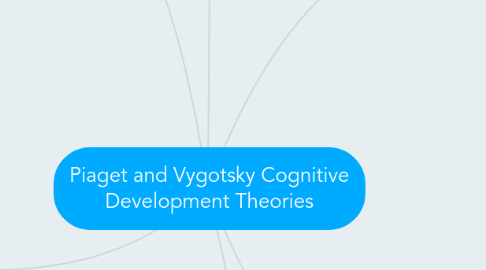
1. Similarities between Piaget and Vygotsky
1.1. Children are active and motivated learners
1.2. Children build knowledge based on previous knowledge. Learning is hierarchical
1.3. Children should be challenged
1.4. Increase complex thinking from previous tasks
1.5. Play fosters learning
1.6. Developmental needs includes interactions physically and through social environment.
2. Group Prespective
2.1. Children need to have "buy in" or need to be invested in the learning to have maximum gains
2.2. Challenges drive cognitive development
2.3. Culture is of paramount importance - certain skills will be developed easier or faster due to cultural demands
2.4. Language and communication is essential for cognitive growth
2.5. Children go through a process of accommodation and assimilation to construct meaning
2.6. Students learn through interactions with others
2.7. Learning is hierarchical
3. Differences between Piaget and Vygotsky
3.1. Piaget: child's culture might have an impact in thinking skills, but never truly explored the idea; Vygotsky: culture is of the utmost importance in sculpting thinking skills
3.2. Piaget: cognitive development mostly driven by child's own efforts; Vygotsky: development driven by guided exploration/instruction by adults/teachers
3.3. Piaget: Stages of cognitive development occur in a range of ages; Vygotsky: there is no mention of age ranges
3.4. Piaget: acknowledged language enhances cognitive development but isn't a requirement; Vygotsky: language is essential for cognitive growth
4. Piaget
4.1. Children behave consistently in similar ways by reacting to their surroundings - Piaget refers to these as schemes.
4.2. Schemes start as concrete tasks that over time become abstract.
4.3. When children know how to react to situations, using their developed schemes to react to a situation, they are in a state of "equilibrium"
4.4. If children encounter circumstances where they can't make sense of a situation or do not know how to react to a new situation, they are in disequilibrium
4.5. There are four stages of cognitive development, and there are onset ages associated with each stage
4.5.1. Each stage provides a foundation for the following stage (stages are hierarchical)
4.5.1.1. Sensorimotor
4.5.1.1.1. Starts at birth
4.5.1.2. Preoperational
4.5.1.2.1. Emerges around age two
4.5.1.3. Concrete Operations
4.5.1.3.1. Emerges around 6 or 7 years of age
4.5.1.4. Formal Operations
4.5.1.4.1. Emerges around 11 or 12 years of age
4.5.2. Major neurological changes is one of the main reasons why stages exist (brain maturation comes with age)
5. Vygotsky
5.1. Sociocultural Theory
5.1.1. It is driven highly by cultural influence because cultural demands will help children develop cognitive tools specific for the success in their culture.
5.1.2. Society and culture influence children's growth
5.1.2.1. Through informal conversations and formal schooling
5.2. Cognitive Tools
5.2.1. Adults pass along specific tools. Either physical or cognitive tools.
5.2.1.1. One important cognitive tool is language
5.3. The more support children have from others, the more cognitive develop they will encounter.
5.3.1. Ranges from tasks children can complete without help, tasks children can complete only with some support, and tasks children cannot complete even with support.
5.4. Zone of Proximal Deelopment (ZPD)
5.4.1. ZPD changes over time. Some tasks are mastered while more challenging tasks appear.
5.4.2. These are tasks that children can perform only with the support of others. Children only truly learn when they encounter a challenge
5.4.3. Once a task is mastered, the ZPD changes for that child.
6. Modern Applications of the Theories
6.1. Piaget
6.1.1. Playing "Devil's Advocate" when students display egocentric thinking, to show them there are other points of view (developing empathy).
6.1.2. Use students' idealism for public benefit, such as participating in the recycling club to reduce waste buried in landfills and/or organizing canned food or clothing drive for local charities or shelters (or any community service related activity).
6.1.3. Teachers can express confusion when young children are demonstrating egocentric thinking.
6.1.4. Relate abstract ideas to concrete material
6.2. Vygotsky
6.2.1. Guided instruction with science labs; teacher modeling and/or instructing students step by step such as with my frog dissection lab.
6.2.2. Giving my students a mnemonic: King Phillip Came Over From Great Spain, to help them remember the order of the taxonomic system: Kingdom, Phylum, Class, Order, Family, Genus, and Species.
6.2.3. Allowing students to coach each other through challenging tasks or have students develop an "expertise" and explain information to their piers (as opposed to teacher instruction)
6.2.4. Encourage students to use self-talk during challenging tasks.
6.2.5. Students work in small groups on more complex tasks (such as Kagan cooperative learning).
